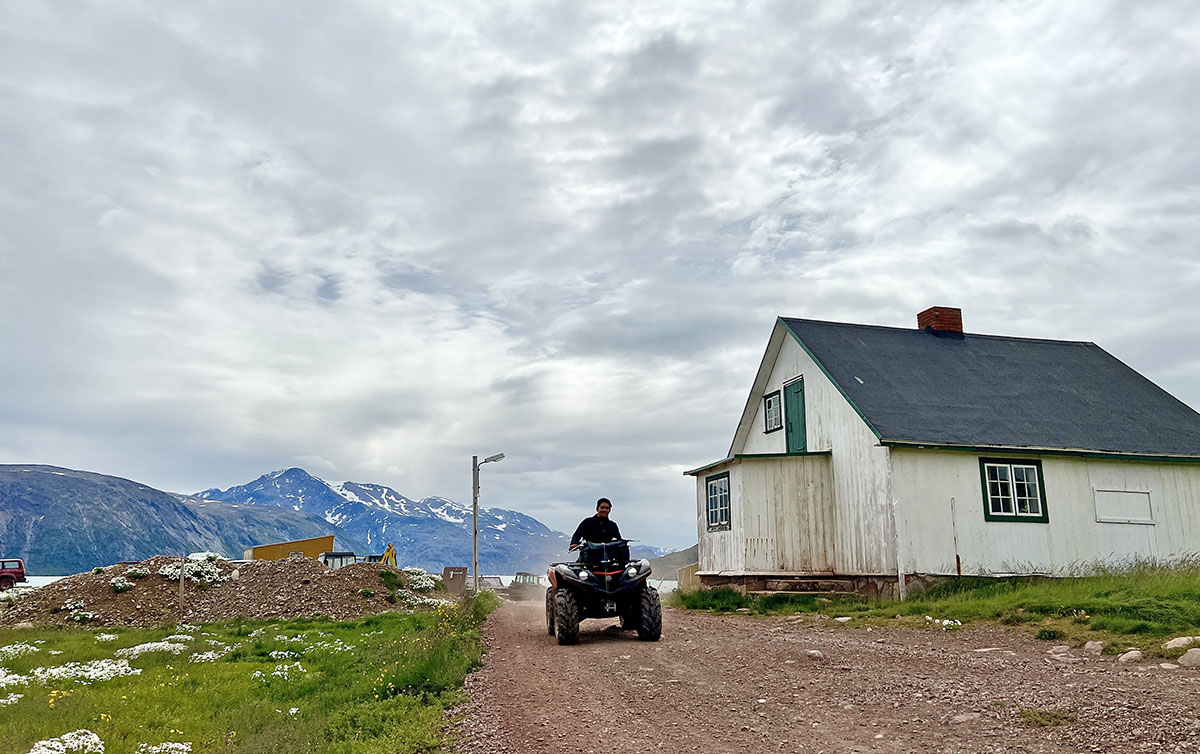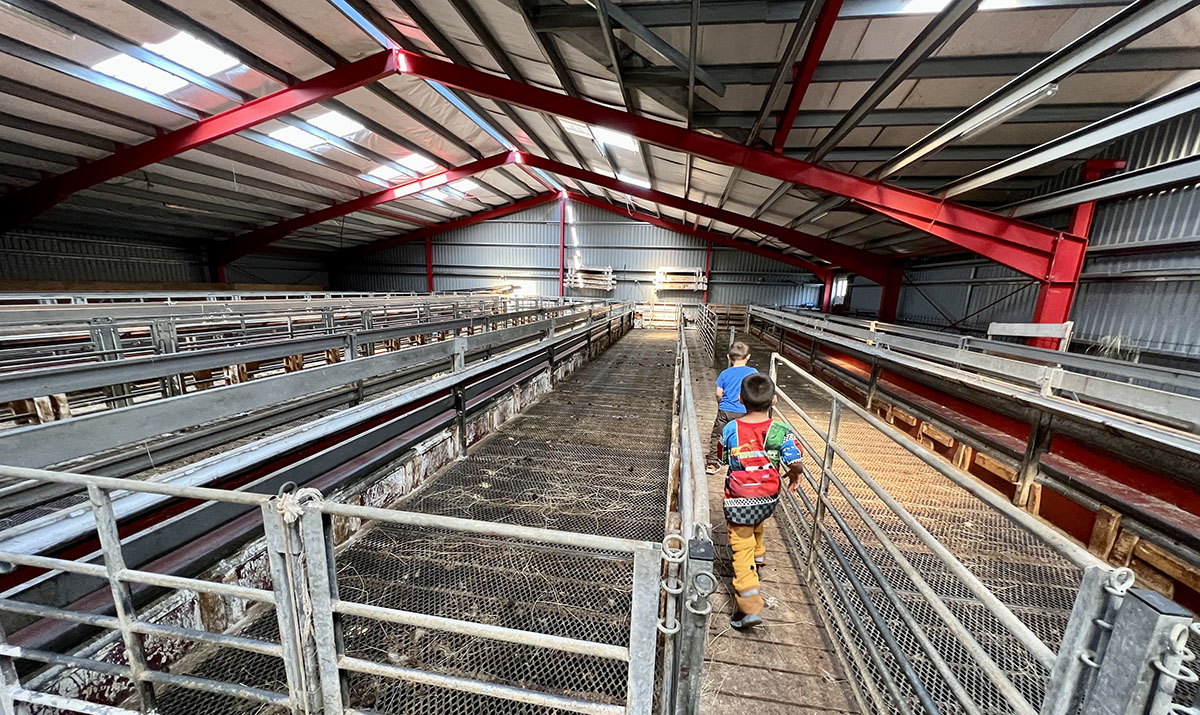As I crested a rise along the King’s Road, a gravel track winding through the Greenlandic hills, a sweeping view of the fjord greeted me. So, too, did a familiar scent: freshly cut hay.
The hike, along the only road access to Igaliku, a settlement with both recent sheep farming and Viking history, had been a study in the familiar. Handfuls of sheep dotted the hills. A tractor pulling a wagon rattled down a side gravel track to a large farm. And that fresh scent of hay. I searched for the source. There. A small triangular field skirted the shoreline, the rows almost glowing green. Even here, life goes on. The feed must be stored for winter.
These past six months have been a messy tangle of introspection, rawness, grief and, hopefully, some healing. I pulled inward and ruthlessly picked away at the tangle, unraveling first one thing and, then, another. What led to that tangle? Perhaps it’s better to ask: what didn’t? A brutal winter. Life and death on the farm. Life and death in my family. Personal reckoning, perhaps brought on by a never-ending pandemic. Or, perhaps, it was time for some self-examination.
And then, we decided to make the trip for the North Atlantic Native Sheep and Wool Conference, in Narsarsuaq. South Greenland. It had been my mother’s dream to go. All I knew is that it’s not easy to get there, but I itched for travel.
The drawback of supporting the work to promote remote native sheep breeds, and the cultures that revolve around them, is the difficulty in reaching those places. For some of us, Iceland was the gateway. We trickled into the small Reykjavik Airport, on a cool, cloudy July morning. It offered our one chance that day to fly into Narsarsuaq.
Common ground
We excitedly introduced ourselves as we prepared to board our plane. “I heard you talking about sheep!” The sheep world, especially when it revolves around fiber, is a close — er, pardon the term — knit group. Such introductions are standard. As I chatted with folks, I felt some of the weariness lift. The pandemic revealed what we often overlook: we are inherently communal creatures.
And so, it began. I never would have guessed a spark of reconnection after years of pandemic limbo would take place thousands of miles north, on the shores of glacier cold fjords, in the stillness of rocky crags and in the laughter of farmers like me, accustomed to nature’s extremes at the edge of the world. The entire globe understands what I and you and everyone else around us has been going through. They’ve missed family members. Mourned loved ones and friends from a distance. Tightened their belts when their economies contracted.
They too understand the inevitable punctuation of our lives now. Before the pandemic. And … whatever we’re in now.
Challenges

We met early one morning for breakfast. The gentle flow of Inuit conversation swirled around me. Sheep farmers and advocates for Greenland agriculture crowded around the table. I’d asked to meet with folks to find out more about raising sheep in a very tough climate. But it turned into a give and take. I asked questions. And answered them. As the conversation flowed, we compared marketing practices and farming management styles.
“Sheep farming is very dependent on the weather in Greenland,” said Tupaarnaq Kreutzmann Kleist, who has farmed for six years with her husband, Aaqqioq Kleist. “It’s very vulnerable.”
Anyone who farms knows it can turn on a dime. The Greenlandic farmers recalled a recent drought. They looked outside of Greenland for livestock feed. Canada, which is geographically close, might as well have been on the other side of the world. In order to get feed, as a Danish outpost, they would have had to ship it to Denmark first, before it could reach Greenlandic shores. More recently, they ended up getting fodder through Denmark, by way of Ukraine, which now represents another set of challenges. Ain’t bureaucracy grand?
“One word. It comes down to one word: logistics,” said Sarah Woodall, who works with Innovation South Greenland. There are road blocks in how they can market their meat and their fiber and skins, too. That also comes down to logistics.
Hard work
Most farmers have outside jobs or diversify what they do — so what does it take to be a full time farmer? Arnaq Bjerge Petersen is the park ranger for Kujataa UNESCO World Heritage sites, but also spent about 20 years farming.
Her response was immediate: “Work, work, work, work,” she said, clapping. “If you want to live on sheep farming only, you really have to concentrate and work … You really have to work hard.”
Although farming is a family affair, there is no individual land ownership as we know it and no inheritance of land. Farmers apply for plots. In simple terms, it’s more of a mutual agreement, rather than deeded ownership. It changes the way younger generations view farming. Skyrocketing prices and low return on sheep meat is putting the pinch on the industry as well.
Some of the folks sitting around the table had farmed their whole life. Others, like Tupaarnaq Kleist, are relative newcomers. They have all grown up with the complicated history. At one point, aspects of traditional music and culture was forbidden. That’s not true anymore, but the memories remain. And perhaps that’s the draw to be a farmer: independence.
“It’s a lifestyle,” Kleist said. Really, they agreed, they couldn’t imagine living any other way. It offers the potential for self sufficiency and control.
Later that day, a group of us took a boat across the fjord and piled into a truck and all terrain vehicles to traverse a rough gravel stretch to the Kleists’ farm. We toured their farm and talked about the opportunities. Tupaarnaq Kleist’s eyes light up when she considers the opportunity present in wool.
There is potential, it seems, for the Greenlandic sheep farmers. Time will tell. I know I found respite and a form of healing there.
That morning’s discussion paused as the folks around the table considered the question of why they farm. Petersen add a word of caution. “You have to find the balance, and that can also be hard.” I think we can all relate.
















